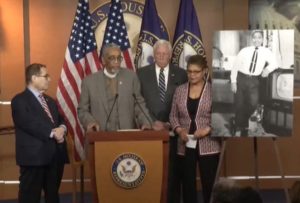What Makes Michael Brown’s Killing Different From the Rest?
Mychal Denzel Smith, a contributing writer at The Nation, argues that the impetus behind the Ferguson protests isn't the slaying of one unarmed black man since the incident is not uncommon in present-day America. Flowers for the 18-year-old Michael Brown, who was shot dead by a police officer in Ferguson, Mo. peoplesworld (CC BY-NC 2.0)
Flowers for the 18-year-old Michael Brown, who was shot dead by a police officer in Ferguson, Mo. peoplesworld (CC BY-NC 2.0)
Mychal Denzel Smith, a contributing writer at The Nation, argues that the impetus behind the Ferguson protests isn’t the slaying of one unarmed black man since the incident is not uncommon in present-day America. According to Smith, it was the fact that Michael Brown’s “bullet-ridden, bloody body [wast left] rotting in the street” that elicited such a strong response from a community and a country teeming with racial tension. It is, Smith contends, the equivalent of a modern-day lynching that has fueled a movement that is unlikely to let up despite an appallingly violent response from authorities.
The Nation:
I’ve been trying to figure out why so many people have had such a strong reaction to Brown’s killing. Because this isn’t new. His death is tragic, but fairly ordinary in the course of black people’s interactions with the police. We deal with this all the time.
On her MSNBC show this past Saturday, Melissa Harris-Perry demonstrated just how ordinary it is. She read a list of names of unarmed black men killed by police in the last decade alone, and it was chilling, to say the least. “Timothy Stansbury, unarmed. Sean Bell, unarmed. Oscar Grant, unarmed. Aaron Campbell, unarmed. Alonzo Ashley, unarmed. Wendell Allen, unarmed. Jonathan Ferrell, unarmed. Eric Garner, unarmed,” she said, before adding, “From 2006 to 2012, a white police officer killed a black person at least twice a week in this country.”… It’s business as usual for police to kill black people. And those are only a few names—many more black men and women have been killed by police. Many of them were also unarmed. Many were around the same age as Michael Brown. So what makes him special? Why did his death elicit such a strong reaction?
Of course, there are several factors to consider. That he was a young black man and not a young black woman is part of it. Black women/girls are often forgotten as victims in the discussion of police violence. That he was regarded as a “gentle giant” (Brown was 6’4″ tall and close to 300 pounds) and a prospective college student are relevant. His image as “harmless” and “respectable” makes him more sympathetic to some people. That a mostly white police force routinely harasses black residents of Ferguson matters. And the fact witnesses say at the time of his shooting Brown had his hands up in the air, surrendering, also matters. It makes the six bullet wounds he suffered appear even more callous.
But for me, the detail that sticks is that Brown’s body was left in the street for at least four hours. Not only did people in the community witness the shooting, they were forced to look at the aftermath.
—Posted by Natasha Hakimi Zapata
Your support matters…Independent journalism is under threat and overshadowed by heavily funded mainstream media.
You can help level the playing field. Become a member.
Your tax-deductible contribution keeps us digging beneath the headlines to give you thought-provoking, investigative reporting and analysis that unearths what's really happening- without compromise.
Give today to support our courageous, independent journalists.






You need to be a supporter to comment.
There are currently no responses to this article.
Be the first to respond.